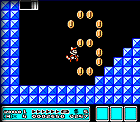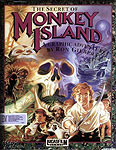
1989 brought a remake of Pinball Wizard in the form of the awful Fred Savage vehicle, The Wizard. The movie was essentially a ninety-minute commercial for Nintendo's biggest selling NES game, Super Mario Bros. 3. SMB3 was also one of the first NES cartridges to boast a larger internal memory chip. Since upgrades could not necessarily be performed on the system itself, Nintendo made its games better over the years by packing more processing power into its cartridges. Musically, this allowed for primitive canned samples of various percussion instruments, which made the soundtracks more realistic  (MP3, 267KB).
(MP3, 267KB).
As you can hear from the sample, Nintendo music was still organized according to the original spec, with melody, a bass line, and drum sounds on separate tracks. The limitations of this format did nothing to hurt the music of 1990's Final Fantasy, which many gamers rate as the best game soundtrack ever written for the NES. Composer Nobuo Uematsu, who wrote the original cinematic-sounding score continues to compose music for the Final Fantasy franchise today.
On the PC, game music took an incredible leap forward with the introduction of sound cards. Sound cards around 1988 fell into three general categories: Ad-Lib, Sound Blaster, and Roland. Ad-lib was the original FM synthesis card, which recreated instrument tones through mathematical adjustment of pitches. This method was inexpensive, and powered many of the electronic keyboards in the 80s, and sounded amazing after spending years with the PC's internal speaker.
The Creative Labs Sound Blaster was a latecomer to the sound card market, and attempted to break Ad-Lib's stranglehold on the market by incorporating digital sound as well as FM synthesis on its card. Given that Creative Labs is essentially the only mass-market soundcard manufacturer around today, it's apparent that their early attempts at proliferation paid off.
The Roland MT-32 had very little foothold in the consumer market, but it was on every musician's wishlist. Instead of relying on FM synthesis, the MT-32 stored a variety of recorded sound samples which gave instruments a new level of reality. This wavetable synthesis idea is still used today in modules like the SC-8850. With a price measured in hundreds of dollars, it was the module of choice for game developers to write their music on, even though the FM recreations of those scores could never match up.
Sierra On-Line, the prominent graphical game designer of the time and makers of all the "<insert noun here>" Quest games struck a deal in 1988, adding music that utilized sound cards in all their games after King's Quest IV. As more and more gamers realized how much real music could enhance a gaming experience, soundcards became more standardized, and now they're generally included in any new computer.
The plight of those who couldn't afford sound cards worsened. As game developers used their new sound toys to their fullest advantage, they were also responsible for making their music backwards compatible with the internal speaker. This resulted in great songs being reduced to the "one note at a time" variety. After soundcards became popular, music that was written specifically for the internal speaker actually sounded better than the new transcribed music. After several more Quest games, Sierra finally decided that they would no longer use the internal speaker in new games. Gamers either had to play in silence or go sell their cat for a soundcard.
As game music gained acceptance on the PC scene, a game's soundtrack became as important as art direction and animation. Composers with computer skills were brought in to write a game's music during its development cycle. Gone were the days of the developer tossing his own tunes into the mix at the last minute.

The early 90s saw a wide array of fresh and inspired soundtracks. LucasArts (then LucasFilm games) has always had a reputation for strong games and even stronger music. When they released The Secret of Monkey Island in 1990, it was the first game with a strongly-cohesive musical feeling, helped by its fresh reggae beat  (MP3, 265KB).
(MP3, 265KB).
LucasArts also created the imuse system of game music composition, which was unfortunately discontinued after a few games. In games featuring imuse, like Monkey Island 2 in 1991, the musical soundtrack never stopped. Instead, the theme from one room of the game smoothly transitioned into the next theme when a character walked around. This is amazing, when you consider that for any given song, a transitional phrase must be written for every bar, so that there's a musical phrase for every possible instant that the player could move around. I remember spending quite a bit of time just wandering between rooms, to hear the ingenuity of composer Michael Land's transitions.
Another company known for its great soundtracks was Origin Systems (which has since been bought and destroyed by conglomerate, Electronic Arts). The 1990 game, Ultima VI, had the protagonist attempting to restore peace between two fantasy races, humans and gargoyles. While traveling in their respective homelands, players heard each race's theme, fully orchestrated. At the climactic moment, when both races had made peace and joined together, I was startled to hear both themes played simultaneously! The joining of melody and countermelody was not only refreshing, it was significant to the underlying theme of the game.
Following Ultima VI, Origin released Savage Empire, which spiced up the game music world with tribal-themed music. It was with this game that the limitations of music technology began to show their seams. The theme from one section of the game depicts an alien city that became too powerful and fell to chaos  (MP3, 1.5MB). The music, which must have sounded great in the composer's mind, almost falls flat on its coda in FM synthesis.
(MP3, 1.5MB). The music, which must have sounded great in the composer's mind, almost falls flat on its coda in FM synthesis.
Tomorrow: Super Nintendo and General MIDI
|
tagged as
music,
games
|
permalink
| 0 comments
|
|
|
Previous Post: Untitled Post |
Next Post: Untitled Post |
You are currently viewing a single post from the annals of URI! Zone history. The entire URI! Zone is © 1996 - 2024 by Brian Uri!. Please see the About page for further information.
